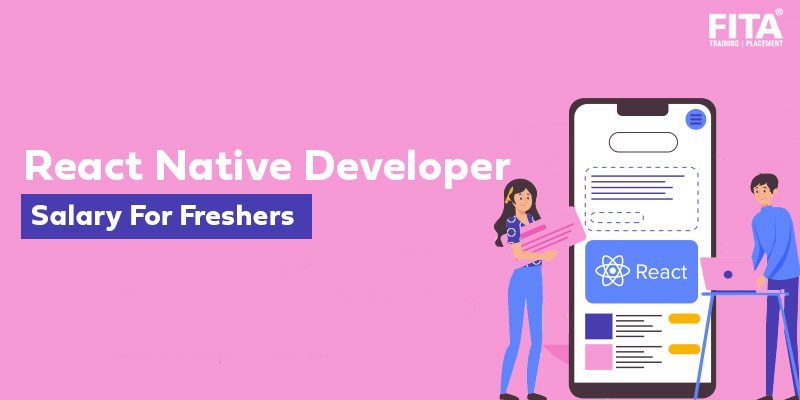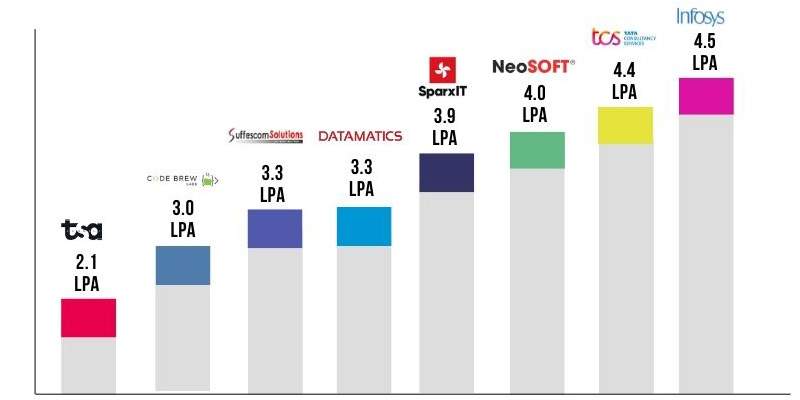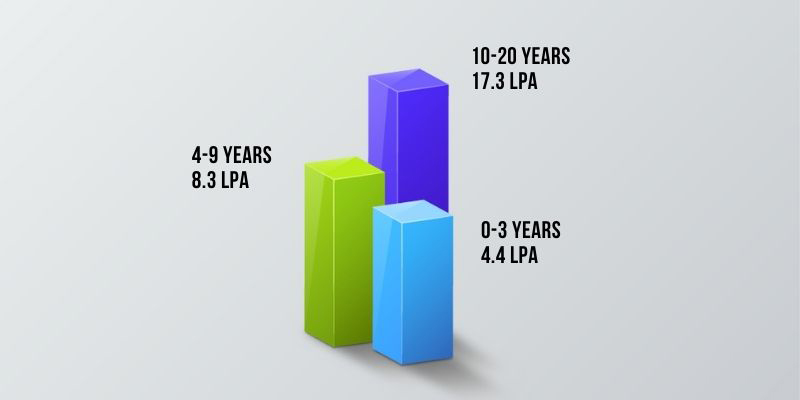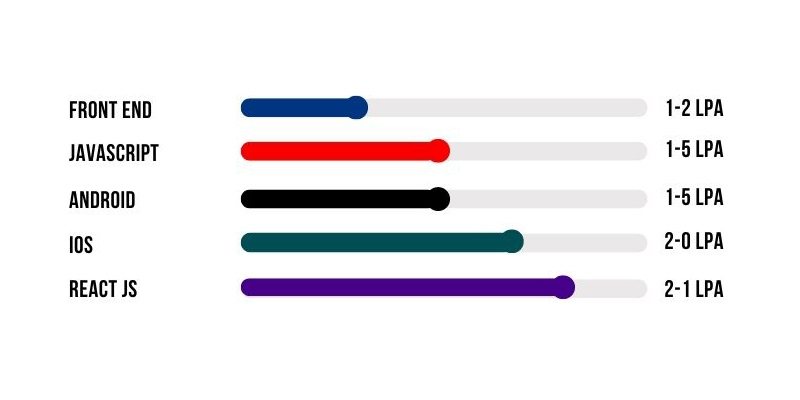
Many people are curious about React Native Developer salary for freshers in India. React Native is a new technology created by Facebook for building mobile apps. React Native is popular because it can be used to build apps that look and feel like native apps but using JavaScript. As React Native Developer salary in India grows, so too will the demand for those with the skills necessary to create React Native applications.
React Native is a cross-platform mobile application development framework that allows developers to build applications using JavaScript. It was developed by Facebook and released as open source on GitHub. React Native uses the same concepts of HTML, CSS, and JavaScript but it runs on top of the native platform APIs. This means that your app will run faster than if you were building an app with other frameworks such as Xamarin or Ionic Framework. The main advantage of this technology is that it can be used both in native mobile applications and hybrid apps.
React Native has become one of the most popular technologies for developing cross-platform mobile apps because of its ability to create high quality native looking apps. As a result, there are many job opportunities available for those who want to work as a React Native developer. According to Indeed, the approximated average pay for a React Native developer is 1.8 LPA However, some companies offer higher salaries for experienced developers.
The best part about working as a React Native developer is that you get to learn new skills and use different programming languages. You also get to work from anywhere since you don’t need any special equipment to code. FITA Academy provide you with React Native Training in Chennai and to also help you learn in a quick and effective way. Another benefit is that you can easily find jobs as a React Native developer since there are so many companies that are willing to hire people with this skill set.
Who is a React Native Developer?
React Native developers are the ones who create apps for Android and iOS using React. They use JavaScript, HTML, CSS to build native mobile applications. The job profile of a react developer includes building web-based UI components that can be used in an app. This means that you will have to learn how to code in both frontend (HTML/CSS) and backend (JavaScript). If you already know how to code then you might consider becoming a React Native developer.
What does a React Native Developer do?
A React Native developer works on creating user interfaces for mobile devices. They need to understand what kind of features should be included in an app before he starts coding. Once the design is ready, the developer creates the UI using JavaScript. Then, he or she converts the UI into native code using tools like Expo. Finally, the developer tests his or her app on various platforms. Learning through instructor led JavaScript Training In Chennai to acquire the know-how and expertise on how you can effectively use JavaScript.
Salary trends
React Native developers in India are in high demand and are commanding salaries that reflect this demand. If you are considering a career in React Native development, it is a good time to get started.
Overall, it seems that React Native developers in India are earning salaries that are on par with their counterparts in other countries. This is likely due to the fact that the demand for React Native developers is high, and the supply of qualified developers is relatively low.
As far as specific salaries go, it seems that React Native developers in India are earning somewhere in the range of Rs. 4 lakhs to Rs. 8 lakhs per annum. This is a wide range, and salaries will vary depending on factors such as experience, skillset, and location.
However, we can take a look at some general trends based on Different Companies, work experience and skills to get an idea of what React Native developers in India are earning.
Salary Range Based On Different Companies
So, to clear things up, here is a list of React Native salary ranges as per different companies in India. The numbers are approximate and might vary depending on the location, experience and skills of the React Native Developers. The salary range for React Native Developers according to companies in India varies.
The approximated salary range for React Native Developer based on different companies is provided by ambitionbox so that you can get an idea of where you should start your career.
Salary Range Based On Work Experience
According to Ambition Box, the median salary for a React Native developer was 4 LPA to 8 LPA based on experience and skills. However, this varies based on experience and skills. For example, a React Native Developer with five years of experience can expect to earn more than someone with one year of experience. Furthermore, engineers with specialized knowledge in React Native may command higher salaries.
To develop your React skill you can enroll in our React Native Online Course and then move on to where you’ll learn all the fundamentals of React Native development.
Salary range based on skills
React Native is an incredible technology for building user interfaces. React Native developers have a lot of skills that make them valuable in the market. React Native salaries can vary based on a developer’s skills and experience. As it becomes more popular, salaries will continue to rise.
The React Native developer needs to possess extensive technical skills and deep domain expertise in both React and native technologies. This enables them to build cross-platform apps easily and quickly. They must have a strong background in building native iOS and Android applications. Also, they needs to know how to work efficiently with different frameworks including Xamarin, PhoneGap, Cordova, Ionic, and others.
React Native Developer Roles And Responsibilities
A react native developer works on the frontend part. They creates custom components and integrates it into the existing codebase of the application. These components are used to display information about the app. This includes login screens, splash screens, progress bars, etc.
The developer needs to know how to use APIs and integrate them within the application. For example, they might write code to retrieve data from a server and display it on screen. In addition, the developer must understand the architecture of the application and how to make changes to the backend.
Why Hire React Native Developer?
Hiring React Native Developer not only saves your time but also results in better performance, speed, and user experience. You don’t have to learn anything else to develop apps. Just hire a React Native Developer and let him take care of everything. He’ll handle every aspect of development process including design, coding, testing, deployment etc.
The following are some of the key features of React Native:
- Fast Development Cycle- You don’t need to write code twice because all the logic is written in JavaScript.
- No Build Time- Your app builds itself when you save changes.
- Easy Deployment– Once your app is ready, you just have to upload it to the App Store or Google Play store.
- Less Code- You only need one set of code to work across multiple platforms.
- Better User Experience- Users get better experience because they do not have to download any additional software.
- More Secure- Apps built with React Native cannot be hacked into because there is no access to underlying system files.
- Better Performance- Because React Native does not use third party libraries, it performs much better than other technologies.
- Good Documentation- There is good documentation available online about how to create different components.
- Open Source- React Native is an open source project which means that anyone can contribute to its development.
- Flexibility- Developers can choose from many UI elements and design their own components.
- Easier Testing- Since testing is done through JavaScript, it is easy to test and debug.
- Faster Learning Curve- As compared to other technologies, learning React Native is easier.
- Cross Platform Compatibility- If you want to build an app for both iOS and Android, then React Native is the best option.
- No Third Party Dependencies- You don’t need to worry about installing external dependencies like Java, Objective C etc.
- Higher Developer Productivity- With React Native, you can focus more on developing rather than debugging.
- Scalability- You can easily add new features without worrying about compatibility issues.
- Cost Effective- Compared to other technologies, React Native is comparatively less.
- High Quality Applications- When you build an app with React Native, you get high quality applications.
- Rich API Support- React Native has rich support for various APIs including Mapbox, Firebase, Parse, and others.
- Highly Customizable- You can customize almost everything about your app.
Beginner Tips for React Native Developers
The world is moving rapidly towards developing apps for mobiles and tablets. Mobile app development is becoming increasingly important day by day, especially for startups and small businesses. As per statistics, there are about 2 billion smartphones around the globe and this number keeps increasing every day. As the demand increases, the competition among mobile app development companies also increases. So, how do you stand out of the crowd? Here are some tips that might help you answer these questions.
- You must know the basics of programming languages such as Java, Objective-C, Swift, Python, Ruby, etc. The learning process of React Native will not be easy for you if you don’t understand the basic concepts of coding. But, don’t worry; you can easily find tutorials online that teach you the basic concepts of coding. You can even upskill yourself with Java Training in Chennai to understand from basic level to advanced concepts of programming languages.
- Choosing the right technologies to build your mobile app requires research. There are many platforms available today and each one has its advantages and disadvantages. Hence, it’s better to choose the right technology that suits your needs. Taking Flutter, Xamarin, Kotlin, or even React Native as an example, if you want to develop an Android application, there are so many options available to you.
- When choosing a team of developers, it’s best to hire people who are experienced in the field. They will guide you throughout the process and ensure that everything goes smoothly.
- Hire experts who specialize in the particular area of expertise that you require. Experts usually charge less money compared to beginners because they already have experience in the industry.
- Always try to keep your project realistic. Don’t set unrealistic deadlines. Instead, focus on delivering quality work within the given timeframe.
- Try to avoid creating a complex app. A simple app with fewer features works well. However, if you want something really great, you’ll have to spend more time and effort on it.
Beginner level React Native interview question and answers
What is State and how does it work?
State is used to control the component. State also allows the value to store in it. State is mutable, hence it changes whenever you want. You can use state to store the information about the current screen. For example, let us say that we have a login form where we enter our username and password. We can save the entered credentials in the state and then display that information in the next screen. This way, we don’t have to pass those parameters again and again.
How Different is React-native from ReactJS?
React Native uses JavaScript for rendering views. It is based on the concept of components. Components are reusable building blocks which help developers build user interfaces easily. The main difference between React JS and react native is that React Native has its own API’s. These APIs allow developers to interact with the device. And they can access hardware features like camera or GPS etc.
Differentiate between Real DOM and Virtual DOM?
Real DOM: In real DOM, every change made to the view will be reflected immediately. However, this approach is not efficient as it requires frequent updates. Hence, this approach is not recommended.
Virtual DOM: In virtual DOM, only the changed parts of the view are updated. This helps in reducing the number of re-renders. Also, it provides better performance than the real DOM.
What is Redux in React Native?
Redux is a predictable state container. In addition to supporting web browsers, mobile devices, desktop computers, and serverless functions, it enables you to write applications that run across multiple environments.
This means the entire data flow in your application is handled inside a single container while persisting previous state. A Redux store contains three main parts:
- An action creator function- This takes care of dispatching events into your application.
- A reducer function- This receives the action and returns the next state based on the action type.
- A selector function- This selects the part of the current state that the component needs.
Describe Timers in React Native Application?
In React Native applications, there are several ways to use timers. One way is to use the native implementation of JavaScript setTimeout() and setInterval(). Another way is to use third-party libraries like react-native-timer. In this React Native Training in Bangalore, you will learn how to use timers in your React Native application.
How to debug React Native Applications?
The first one is the Developer Menu. You can access it by pressing command+R on macOS or ctrl+M on Windows/Linux. Once you’re inside the Developer Menu, you’ll see a list of options. One of those options is called “Developer”. It is possible to debug your application remotely if you select that option.
For example, let’s say you want to find out why the component isn’t rendering correctly. To do that, you’d go into the Developer mode, and then select “React”. After that, you’d type in “componentDidMount()”, and hit enter. Then, you’d wait for the function to run. If it doesn’t work, you could try changing something in the code, save it, and then rerun the function again. If it still doesn’t work, you might want to check what’s happening during runtime.
You can do that by selecting “Console”. When you do that, you’ll see a window pop up showing the console logs. Here, you can write down whatever errors you see and then fix them.
Another way to debug React Native is to enable live reload. Now, whenever you change a file, the app will reload itself without having to restart.
This feature is especially useful because it lets you know instantly whether your changes worked or not.
If everything goes well, then you can continue working on your project. But if things don’t work, you can always disable auto-refresh by unchecking the box.
What is Props Drilling?
Props drilling is an advanced technique where you pass props from parent components to child components. The idea behind this is to avoid passing unnecessary properties to children.
How to create a custom scroll view in React Native?
A ScrollView is a special kind of View which allows us to scroll through its content. We can add any number of Views inside a ScrollView.
What is the difference between Stateless Functional Components and Class Based Components?
Stateless functional components are functions that return JSX elements. They have no state, and they cannot interact with the outside world.
Class-based components are classes that extend Component class. These components can have state and they can call methods on their parents.
What is the difference Between React Hooks and Redux?
Hooks are a new addition to React 16.8.0. Hooks allow developers to reuse existing logic across different parts of the application.
Redux is a library that helps us manage our data. It has two main concepts: Actions and Reducers. An action is an object containing information about what happened in the UI. A reducer receives actions as input and returns a new version of the state.
What is the difference between PropTypes and TypeScript?
TypeScript is a superset of JavaScript. It adds optional static typing and other features to JavaScript. It also supports decorators like @PropTypes.
What is the difference between ES6 modules and CommonJS Modules?
ES6 modules are used to import files. CommonJS modules are used to export objects.
Do you know if Python can be used with React Native-Explain in detail?
Yes, it can! You simply need to have your python code exported as.js file which is then imported into the react native app using require() method. If you are fresher, this Python Tutorial for Beginners can help you understand all the details of writing Python code in react native app.
The above React Native questions and answers will help you answer common reactive level interview questions and improve your chances of success during a job interview. Remember to be confident, articulate, and answer the questions honestly. You can also use the information in this article to prepare for other interviews, such as technical interviews and get the best react native developer salary in India.
End Summary
If you’re looking to get into the React Native field, then you’re in luck. The React Native Developer Salary For Freshers is pretty high. And, if you have experience in the field, then you can expect to earn even more. React Native is a popular framework for developing mobile applications that can be used by developers with React experience. In this blog, you will have a detailed information about React Native developer salaries for freshers and experienced developers. We have provided some tips on how to get started in React Native development and how to improve your skills.



